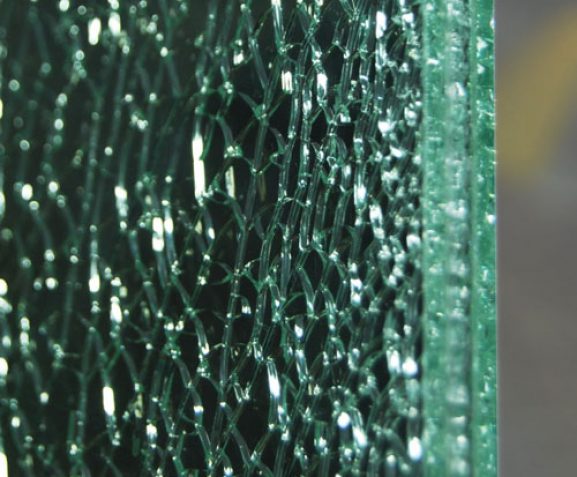Tempered glass
This is created in the heat treatment process – tempering. As a result of this treatment, changes occur in the glass structure that cause the glass to break apart into small, non-sharp pieces that don’t injure a person. During tempering, flat glass blanks are heated to around 680°C and then rapidly cooled with a cold air stream.
Thanks to this treatment, the glass’s resistance is multiplied several times. Such glass has increased resistance to temperature changes (from -100°C to +300°C) and is able to withstand considerable weight pressure. Tempered glass is used in residential, sports, public utility and administrative and office buildings as doors, floors, external and internal balustrades, glass shelves, shower cubicles and table tops. It is also used for the construction of full-glass facades, structural glass and partition walls. Tempered glass is also used to make large capacity aquariums.

Its high strength and increased thermal resistance make this type of glass increasingly used for glazed roofs, skylights, winter gardens and as decorative glass using screen printing motifs.
VITROSZLIF has developed a technology for producing glasses, based on an optimal glass surface treatment technology, through its shaping and the use of photocatalytic coatings applied by the sol-gel method. The multifunctional photocatalytic coating will be applied to glass before tempering, making the entire production process and the project result innovative. The new product will be characterized by increased photocatalytic activity (pollution breakdown), strength and low reflectivity. One of the components of the coating is titanium oxide – thus contaminants can be removed by rainfall and the glasses do not require as frequent cleaning. The easy flushing of contaminants is also related to the superhydrophilic properties of the titanium coating. At present, on the Polish market, Vitroszlif is the only producer of glasses in the production technology of simultaneously tempered and photocatalytic glass in one production process.
Summing up the above, the result of the project will be the introduction of a tempered façade glass with photocatalytic action, which is not offered by other producers.
The new technology will be characterized by:
Functionality – the new façade glass will simultaneously be significantly more resistant to mechanical factors and will feature an increase in photocatalytic activity
Increased glass strength – their security and durability
Optimized low reflectivity – better visibility, better transparency of the glass
Lower price – the new technology shortens the production process, reduces wastefulness, reduces energy consumption to produce the product
The entire production process is much more ecological than the traditional ones
Screen printing and enameling involves the application of enamel. The final design can consist of multiple colors. The glass surface is then dried and the enamel is subjected to a vitrification process – the glass is glazed in the course of thermal processing. In the screen printing technique, the enamel is applied pointwise, and the enameling process consists of applying the enamel to the entire glass surface. This glass is used to mask opaque and structural facade elements. It is highly valued for its high color fastness and wide range of colors, excellent mechanical strength and unlimited choice of patterns. Tempered glass cannot be cut. So if we want to use tempered glass, we must order it to size.
